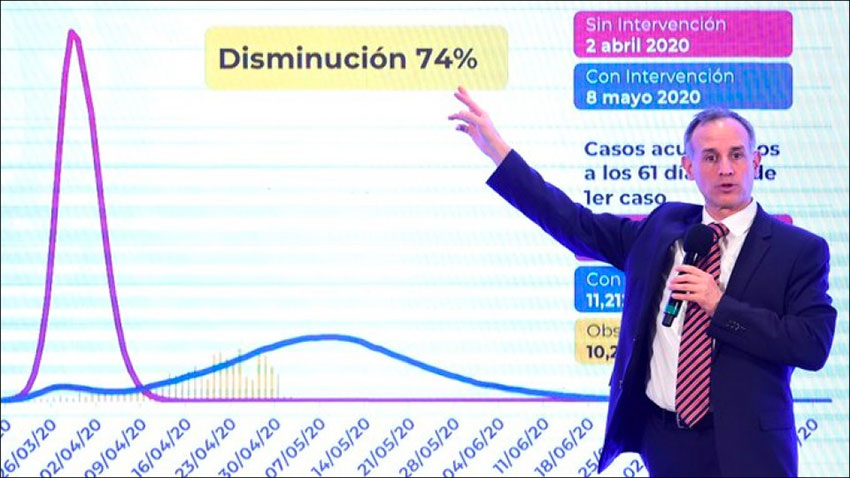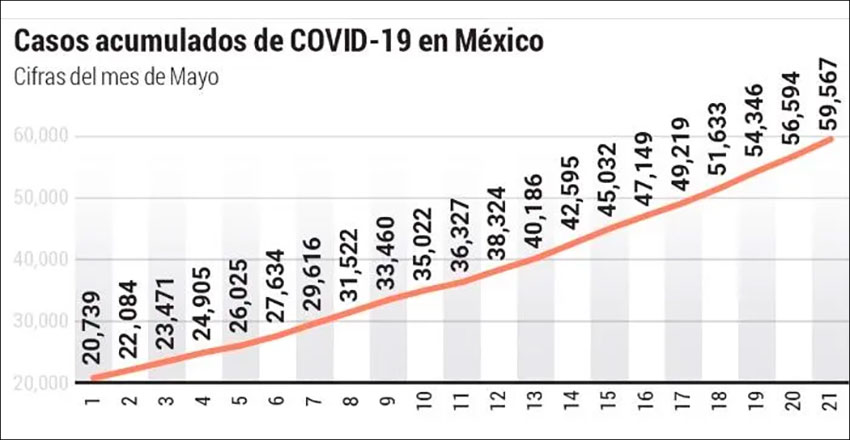“The peak of the pandemic is now a mountain range,” a Mexican Twitter user said last week referring to the federal government’s changing predictions about when the coronavirus outbreak will reach its highest point.
“The peak of infections will be next week – it doesn’t matter when you read this,” read a meme featuring a photograph of coronavirus czar Hugo López-Gatell sporting a beaming grin.
Since early May, López-Gatell, deputy minister for health promotion, has been saying that the peak coronavirus infection period is imminent, although he has stressed that Mexico is not going through one sole pandemic but rather numerous local epidemics as a result of its large geographical size.
As a result, there is not a single national epidemic curve but rather a series of curves for Mexico’s numerous cities and states. New infections are on the rise in some and decreasing or stabilizing in others.
Therefore, different predictions for when different cities will hit the peak of their local epidemics are perfectly valid, although López-Gatell said last week that if the epidemic curves of all 32 states come together as if they are one, the greatest transmission of the coronavirus will occur in the first two weeks of July.
As the aforementioned Twitter post and meme indicate, López-Gatell and the government more broadly have confused much of the Mexican public with the predictions they have publicly presented about when the pandemic will peak. They have indicated on different occasions that Mexico as a whole is on the cusp of the peak infection period even though the pandemic is not behaving uniformly across the country.
In addition to announcing varying predictions about when the contagion peak will occur, López-Gatell has claimed on several occasions that Mexico’s case numbers are stabilizing even as the government’s own data shows that they are trending upwards.
On May 5, he said “the epidemic is slowing down” and “we’ve flattened the curve,” an assertion that was promptly challenged by a National Autonomous University (UNAM) epidemiologist.
López-Gatell made a new “curve-flattening” claim at the Health Ministry’s nightly coronavirus press briefing on May 25 even though case numbers had continued to show steady growth.
The deputy minister has clarified that his assertions refer to a flattening of the curve in comparison with what would have hypothetically occurred had Mexico not implemented coronavirus mitigation measures such as the suspension of nonessential economic activities and the national social distancing initiative. The government’s actions have reduced new cases by as much as 75%, he has said.
However, “a flattening of the curve” in comparison with what might have happened is not how the term is commonly used.

While there is no way of knowing for certain just how effective Mexico’s mostly non-enforceable coronavirus mitigations have been in reducing new infections, hard data shows that case numbers have more than doubled since López-Gatell’s May 25 “curve-flattening” claim.
On that date, the Health Ministry reported that Mexico’s case tally had increased to 71,105. Last night it said that confirmed cases numbered 159,793, an increase of 125% in just over three weeks. An analysis by the Johns Hopkins University confirms that the epidemic curve has not been flattened in Mexico.
But while data shows that Mexico’s coronavirus outbreak has grown quickly in recent weeks, the real size of the pandemic here is undoubtedly much larger because testing rates remain low.
Sebastian Garrido, coordinator of the data science unit at CIDE, a Mexico City university, told the news agency Bloomberg that no one actually knows where Mexico is currently placed on the epidemic curve.
Mexico has made scant efforts to test widely for Covid-19, focusing almost exclusively on people with coronavirus-like symptoms. As a result the percentage of tests that come back positive in Mexico is much higher than in countries that test more widely.
Earlier in the coronavirus crisis, the Health Ministry provided estimates about the real size of the pandemic based on data about possible and confirmed coronavirus cases collected at 375 medical monitoring stations.
López-Gatell said in April that there were likely about eight undetected cases for each confirmed one, according to the data collected by the sentinel surveillance system. If the same estimate applied today, around 1.3 million people in Mexico would have had Covid-19 since the start of the pandemic.
However, the government has not provided any sentinel system updates since April and López-Gatell said in May that it was no longer the principal means of measuring the pandemic because it was no longer practical, given the higher rapidity with which new cases were occurring.
The deputy minister continues to acknowledge that the size of the pandemic is much bigger than official data indicates but no longer presents extrapolated data that undoubtedly has the potential to alarm the population.
Instead, as Bloomberg notes, López-Gatell has sought to diffuse public panic by using his “nice-guy demeanor” and “knack for breaking down complex ideas into easily understandable bits” during his nightly press briefings.
Those attributes have helped him to become the most popular federal official, according to polls, but critics argue that they have also allowed him to conceal the true magnitude of the coronavirus problem, which in turn has made the outbreak worse and placed more lives at risk.
“He knows how to communicate and he knows how to put on a show,” Laurie Ann Ximenez-Fyvie, head of a molecular genetics laboratory at the National Autonomous University, told Bloomberg.

“He has his talking points and he uses them to convince people that this is under control,” she said.
Just as the real number of Covid-19 cases in Mexico is unknown, so too is the number of deaths from the disease.
While accurately counting coronavirus fatalities is undoubtedly much easier than accurately counting cases, there is compelling evidence that the former are being drastically underreported in Mexico City, the country’s coronavirus epicenter.
An analysis by the independent organization Mexicans Against Corruption and Impunity of death certificates issued in the capital between mid-March and mid-May suggests that four times more people died from Covid-19 in the period than the number officially reported.
Several media reports have also claimed that Covid-19 deaths in Mexico City are much higher than the numbers disclosed by authorities.
As of Wednesday, Mexico City had officially recorded 5,042 coronavirus-related deaths but Nexos Datos, a data analysis organization, found that 17,310 more death certificates were issued in the capital between March 30 and June 7 compared to the average for the same period over the past four years.
Researchers said it is unlikely that all of the excess deaths could be attributed to Covid-19, explaining that some were likely the result of people not seeking timely medical attention. However, the 124% surge in deaths in Mexico City almost certainly means that Covid-19 fatalities are being significantly underreported.
Alejandro Macías, the federal government’s czar during the swine flu pandemic in 2009, charged that the federal government is not deliberately underreporting deaths, telling Bloomberg: “They’re not doing it on purpose; they’re not hiding bodies somewhere. It’s just that they haven’t figured out how to do it properly. The systems weren’t ready for this.”
Garrido, the CIDE data scientist, noted that there is a delay in reporting deaths, a point that López-Gatell emphasized after more than 1,000 deaths were reported on June 3.
He said that the lag is likely caused by outdated systems – all the data the federal Health Ministry reports comes from the authorities in the 32 states – as well as legal and medical requirements to certify deaths.
If a suspected Covid-19 patient dies before he or she is tested, and is not tested subsequently, a committee of medical specialists analyzes the case and makes a decision about whether the fatality should be attributed to the disease and added to Mexico’s official coronavirus death toll.
Some Covid-19 fatalities have not shown up in the official death toll for days, weeks or even months after they occurred.
Mexico currently has the seventh highest death toll in the world with fatality No. 20,000 likely to be recorded this week.
The most recent estimate from López-Gatell was that the death toll could reach 35,000, or as many as 60,000 in a worst case scenario, a significant increase from the prediction of 6,000 fatalities he offered in early May.
The Institute for Health Metrics and Evaluation at the University of Washington in Seattle is currently estimating almost 52,000 deaths by August 4.
But despite the alarming predictions, rising case numbers, spiraling death toll and a warning from the World Health Organization last week that Mexico is going through “one of the most complex and dangerous moments of the epidemic,” the economy is beginning to reopen and more and more people are returning to their regular everyday activities.
In central Mexico City, where the streets are gradually returning to their old chaotic self, many residents are taking precautions to protect themselves from the possibility of coronavirus infection by practicing appropriate social distancing and wearing face masks but others appear oblivious to the risk – hugging, shaking hands, high-fiving, fist-bumping and getting up close and personal with friends and strangers alike.
More coronavirus peaks are undoubtedly still to come.
Mexico News Daily
